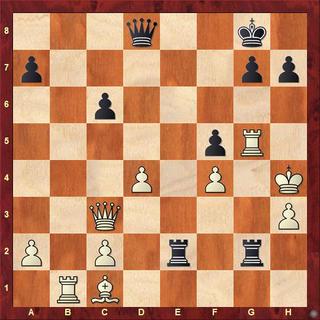Black to Play
Published in Chess Puzzles

Two giants of the 19th century hammered it out in a king’s gambit that went like this: Anderssen,Adolf - Zukertort,Johannes Hermann [C32] Breslau Breslau, 1868, 1.e4 e5 2.f4 d5 3.exd5 e4 4.Bb5+? c6 5.dxc6 Nxc6 6.d4 Nf6 7.h3 Qa5+ 8.Nc3 Bb4 9.Bd2 e3 10.Bxc6+ bxc6 11.Bxe3 Bxc3+ 12.bxc3 Qxc3+ 13.Kf2 Ba6 14.Ne2 Bxe2 15.Qxe2 0–0 16.Rad1 Rfe8 17.Rd3 Qc4 18.Ra1 Re4 19.Qd1 Rae8 20.Kf3 Nd5 21.Bc1 Nc3 22.Qd2 Re2 23.Qxc3 Qd5+ 24.Kg4 Rxg2+ 25.Rg3 Ree2 26.Rb1 f5+ 27.Kh4 Qd8+ 28.Rg5 [See diagram] h6 29.Qc4+ Kh7 30.Qf7 hxg5+ 31.Kh5 gxf4 32.Bxf4 Re7 0–1. Afterwards, it was pointed out that Zuk could have mated his opponent with a different 28th move. What is the mating attack here?
When a king is bumped up the board like that, you always have to look a little closer for the mate: 28…Qxg5+ 29.fxg5 Re4+ 30.Bf4 Rxf4+ 31.Kh5 g6+ 32.Kh6 Rh4#
Send questions and comments to PTamburro@aol.com.







Comments